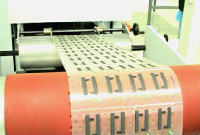By Jonathan Collins
Sept. 3, 2003 – Smart label specialist KSW-Microtec plans to mass-produce thin film batteries using a roll-to-roll manufacturing process. The battery technology has been licensed from Power Paper, an Israeli company,
and will be used to power active RFID labels that have a longer read range and support special features, such as integrated sensors.
KSW, based in Dresden, Germany, has spent two years setting up production facilities that can create the new batteries on roll-to-roll machines. The batteries are produced in a single, continuous process in which the thin-film battery is printed onto rolls of a flexible substrate.
“The difference between this and the sheet technique we have been using is like the difference between day and night,” says Eitan Avni, KSW’s director of business development. “We can now produce millions of batteries a year.”
Active smart labels have many uses in the supply chain and other applications. The battery power enables the RFID tag to send out a stronger signal than passive tags, so they are ideal where read ranges of more than 30 feet are needed. And they can perform better in challenging environments, such as when there is electromagnetic interference and other issues. “We’re only just starting to see the tip of the iceberg of potential for smart active labels,” says Avni.
He adds that battery-powered tags are especially appropriate in medical environments where standard UHF tags could interfere with vital equipment. “We have already signed deals to deliver the TempSens tag to a clinic using them to track tissue samples,” says Avni.
Since July 2002, KSW has been using Power Paper’s thin-film battery technology to power its TempSens temperature monitoring RFID label. The TempSens tag operates at 13.56 MHz and is compliant with the ISO15693 standard. It not only tracks items in the supply chain but records their temperature (New Low-cost Temperature Sensor).
While production numbers ramp up, the TempSens label costs about $4. The goal is to increase production volumes to the point where the tags cost about $1 each, which could take five years. But the trends are positive. KSW recently signed a distribution deal with Global Licensing and Innovation, a smart packaging supplier in Australia. Avni says KSW is seeing strong demand for the tag in the food distribution and medical industries. Avni declined to release sales figures but said KSW will announce a new multinational perishable food-packaging customer shortly.
Avni believes the potential for active RFID labels that use thin-film batteries is enormous, but concedes that it won’t replace UHF for most supply chain deployments. “No way will batteries replace UHF in the supply chain,” he says. “UHF chips will always be priced lower, but tags with batteries may have a role to play where there is a need for read ranges of around 50 feet.”
KSW’s licensing agreement with Power Paper is not exclusive. Graphic Solutions, a Burr Ridge, Ill.-based custom print house, has also licensed the Power Paper technology (see GSI to Produce Thin-Film Batteries).
RFID Journal University
This special series of one-day courses developed by RFID Journal addresses all of the issues you need to understand before deploying RFID technologies. To view the curriculum, including complete course outlines, click here. Or visit RFID U.
|
San Francisco
|
October 7, 2003
|
|
|
New York City
|
October 21,2003 |
|
|
Atlanta
|
November 3, 2003
|
|
|
Chicago
|
November 17, 2003
|
|


